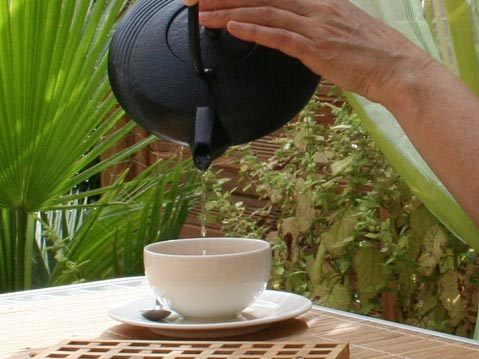To Your Health
The Biochemistry of Tea

There are hundreds of varieties of tea today, all created from a single plant species: Camellia sinensis. People have spent millennia cultivating the tea plant and discovering how to alter the chemistry of its leaves to create different types of teas. Last week in “Biology Bytes” we explored the history of tea. This week we’ll venture into the realm of biochemistry to reveal what gives different teas their distinctive flavors, appearances, and potential health benefits.
It’s in the Leaves: Camellia sinensis, like any plant or living organism, is a complex mixture of many different chemicals. While there is still much we don’t understand about all of the chemicals and chemistry that goes on to make a delicious cup of tea, scientists have discovered many chemicals present in tea leaves that contribute noticeably to different aspects of tea.

Much of it comes down to how the leaves are treated. To look at this, it’s easiest to focus on the two most commonly consumed types of tea: black tea and green tea. To make green tea, fresh tea leaves are steamed, then rolled or dried. For black tea, partially withered leaves are rolled or cut, then allowed to undergo a process called oxidation (the leaves are left to turn brown), then finally are dried.
These processing differences are what make green tea and black tea distinct from each other. Specifically, the chemicals found in green tea are very similar to the ones found in the leaves of the tea plant naturally, whereas because the leaves undergo oxidation to create black tea, black tea contains a variety of chemicals not found in the fresh leaves or green tea. One of the major chemical groups this oxidation affects is the catechins.
Green Tea and Catechins: Polyphenols are abundant in tea leaves and are known to cause many of the properties we enjoy in tea. In nature, members of this large group of chemicals are found mostly in plants and act as antioxidants. (More on the topic of antioxidants to come.) Most of the polyphenols in tea leaves (about three fourths of them) belong to a more specific subgroup called catechins. Several different catechins are present in the leaves, and in the green tea itself they account for up to 30 percent of the weight of dry tea. It’s this high level of catechins that gives green tea its characteristic bitter and astringent taste.
Black Tea: Black tea, however, has a much lower amount of catechins (they only make up about 10-12 percent of its mass) because of the oxidation process; when the leaves are rolled or crushed and left to oxidize to make black tea, chemicals in the leaves that were previously separated from each other are released and can now mix and trigger reactions. Because of this, during oxidation most catechins in the leaves undergo a chemical reaction to become other chemicals (thanks to an enzyme called polyphenol oxidase). Specifically, the catechins couple together to form chemicals called theaflavins and thearubigins. (They’re polyphenols, too).
Most of the theaflavins formed actually turn into thearubigins; ultimately, dried black tea has about one to 6 percent theaflavins and 10 to 20 percent thearubigins. These chemicals are not present in green tea. In fact, the enzymes needed to make these chemicals mostly become inactivated in the green tea by heat when the leaves are steamed.
So what do these “thea-whats-its” do to black tea? Theaflavins are what make black tea a darker, reddish-orange color; they’re molecules of pigment. Thearubigins also contribute to black tea’s color, as they are orange-brown pigments. In addition to color, theaflavins also add to flavor; they are part of what causes black tea to be less astringent than green tea (another key factor is the decrease of catechins in black tea).
But there’s a lot of other complex chemistry that goes into making black tea; just the tip of the iceberg is the many cascading chemical reactions that catechins are thought to undergo, where one chemical product reacts with others, creating the rich diversity of chemicals found in black tea. The chemistry of a lot of these, such as thearubigins, is still not well understood.
An Appetizing Green: Green tea, lacking pigment from theaflavins and thearubigins, has a green color thought to be due to several different chemicals in the fresh leaves, including chlorophyll, carotenoids, and several different flavonols. Chlorophyll gives green tea a bright green coloring, and is just another reason to make sure to drink that tea before it’s been stored too long; chlorophyll, like other essential chemicals in tea, degrades over time, especially at high temperatures and in humid conditions. This is why old tea won’t be as vividly green as fresh tea. Flavonols, though making up less than 1 percent of the mass of the dry tea, nevertheless contribute a bright yellowish green hue and even add to the astringency of green tea by reacting with caffeine.
Caffeine: Speaking of caffeine; it’s probably the most widely known chemical in tea, and acts as a stimulant of the central nervous system and a contributor to tea’s bitter taste. Although dried tea has more caffeine than the same amount of dried coffee, because much less tea is used when making a drink, many may be surprised to learn that a cup of coffee actually has a lot more caffeine than a cup of tea. While a five ounce cup of drip coffee has 60 to 180 milligrams (mg) of caffeine, a same-size cup of black tea only has 25 to 110 mg caffeine, and green tea has even less, at 8 to 36 mg. And caffeine is yet another reason to drink that tea fresh; if black tea is stored too long, the caffeine is thought to degrade and make the tea more bitter.
Theanine and Relaxation: But the stimulating effects of even the relatively low levels of caffeine in tea are curbed by the presence of a chemical called theanine. In nature, theanine (also known as y-L-glutamyl ethlamide) is very rare. In the early 1950s it was first found in tea leaves, but outside of tea leaves, theanine has only been naturally found in one species of mushroom (Xerocomus basius). When tea is consumed, the theanine increases dopamine levels and alters levels of serotonin in the brain, and overall causes a person to feel very relaxed, yet mentally alert, within about 30 to 40 minutes of drinking it. Theanine also greatly adds to the sweet and savory taste of tea, countering and building upon the bitterness of the caffeine and other chemicals. And this induced sense of relaxation is highly prized; usually a high-quality tea has a greater amount of theanine, up to about 2 percent.
Weight Loss? Theanine combined with caffeine, and catechins alone, are also suspected to work to decrease body weight. Catechins are thought to interact with enzymes involved in “burning” fat to do this. In experiments where people were given catechin extracts for three months, it was found that people taking the extracts lost slightly more weight than those who weren’t. But these catechin doses were at levels far higher than those found in normal tea; it’s still unclear whether drinking tea normally and casually significantly affects weight.
Antioxidants: Many of the chemicals in tea discussed above have antioxidant properties: catechins, theaflavins, and thearubigins in particular. Catechins (particularly the main catechin in tea, epigallocatechin gallate, or EGCG) are thought to be even better antioxidants than vitamins C and E. But this isn’t so surprising; lots of antioxidants are in fruits and vegetables in general. Antioxidants have received a lot of attention in recent years because they may reduce the risk of different diseases, such as cardiovascular disease and cancer, and are even thought to possibly decrease aging.
But how well-founded are these claims? In the 1950s it was found that our bodies withstand damage all the time inflicted upon us by natural reactive molecules called free radicals (also known as reactive oxygen species). These energetic free radicals can run into other molecules in our cells and damage them. Researchers thought that our bodies must take countermeasures to fight these free radicals through “antioxidants.” But in the last few decades, researchers have been testing whether antioxidants can combat the diseases mentioned above and only a few studies have shown any encouraging results, while the rest (the majority) didn’t show antioxidant supplements to be at all beneficial.
While the antioxidant theory may not be completely off, it is most likely much more complicated than we think it is; many factors are involved in any given diet. But eating lots of fruits and vegetables, even if antioxidants aren’t a miracle cure, is still probably a very safe bet for a healthy lifestyle.
Drinking to Your Health: Drinking tea is thought to reduce the risk of a number of other diseases in addition to those discussed above. It is supposed to improve the functioning of the central nervous system, kidney, liver, and immune system, as well as mental function, cholesterol levels, digestion, hypertension, tooth care, diabetic conditions, and even aging. It sounds like a miracle elixir; but many studies have had inconsistent results, and the chemical mechanisms that go on in our bodies are not well understood.
To fight cholesterol and blood clots, it’s thought that something in tea (it’s not yet clear exactly what, but catechins are suspected) works to prevent cholesterol from accumulating in the bloodstream, possibly preventing strokes and heart attacks. Theanine, specifically, is suspected to boost cardiovascular activity and immunity. A number of vitamins are also present in tea, particularly vitamin C, which may also help with boosting the immune system. But more detailed studies need to be conducted to confirm these claims and theories, and to determine the exact chemical mechanisms by which tea operates in our bodies to bring this all about.
While chemicals in tea have been extensively studied in laboratories and these experiments have suggested that these chemicals may have various beneficial properties, understanding how the chemicals actually function in something as complex as a human body is a very different matter. In addition to performing the amazingly difficult task of parsing apart how one small aspect of a person’s diet affects their health, researchers also have to take into consideration how lifestyles and other differences further complicate the matter. It’s a daunting endeavor. But it’s important to keep funding research even if it may not seem very relevant at the time; it’s hard to predict where the cure for a currently incurable disease, such as cancer, may lie in wait for discovery.
For more details on tea and its biochemistry, see Mary Lou Heiss and Robert J. Heiss’s book The Story of Tea, Kit Chow and Ione Kramer’s book All the Tea in China, Bennett Alan Weinberg and Bonnie K. Bealer’s book The World of Caffeine, Yukihiko Hara’s book Green Tea: Health Benefits and Applications, Chi-Tang Ho, Jen-Kun Lin, and Fereidoon Shahidi’s book Tea and Tea Products: Chemistry and Health-Promoting Properties, Joe Schwarcz’s wonderful biochemistry books Dr. Joe & What You Didn’t Know, An Apple a Day, and Science, Sense, and Nonsense, the FDA’s 2005 news release on FDA Issues Information for Consumers about Claims for Green Tea and Certain Cancers, the University of Maryland’s Medical Center’s Web site on green tea, or Wikipedia’s articles on Tea, Camellia sinensis, and the Health Effects of Tea.
Biology Bytes author Teisha Rowland is a science writer, blogger at All Things Stem Cell, and graduate student in molecular, cellular, and developmental biology at UCSB, where she studies stem cells. Send any ideas for future columns to her at science@independent.com.



